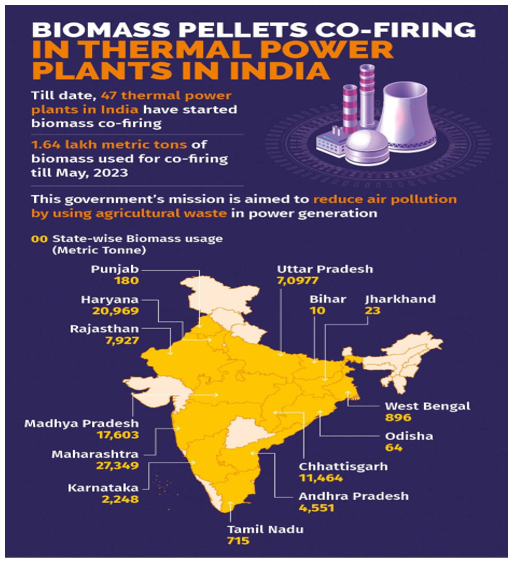- Courses
- GS Full Course 1 Year
- GS Full Course 2 Year
- GS Full Course 3 Year
- GS Full Course Till Selection
- Online Program
- GS Recorded Course
- NCERT (Recorded 500+ Hours)
- Polity Recorded Course
- Geography Recorded Course
- Economy Recorded Course
- AMAC Recorded Course
- Modern India, Post Independence & World History
- Environment Recoded Course
- Governance Recoded Course
- Science & Tech. Recoded Course
- International Relations and Internal Security Recorded Course
- Disaster Management Module Course
- Ethics Recoded Course
- Essay Recoded Course
- Current Affairs Recoded Course
- CSAT
- 5 LAYERED ARJUNA Mentorship
- Public Administration Optional
- ABOUT US
- OUR TOPPERS
- TEST SERIES
- FREE STUDY MATERIAL
- VIDEOS
- CONTACT US
CO-FIRING BIOMASS PELLETS IN THERMAL POWER PLANTS
CO-FIRING BIOMASS PELLETS IN THERMAL POWER PLANTS
09-08-2023

Latest Context
In a recent written reply to the Rajya Sabha, the Union Minister for Power and New & Renewable Energy offered insightful information on the Revised Biomass Policy and the 47 Thermal Power Plants that have successfully integrated the co-firing of coal with biomass pellets made from agricultural residues.
According to the Ministry of Power, up until May 2023, 47 coal-based thermal power plants co-fired about 1,64,976 metric tonnes of biomass made from agricultural wastes.

What is the Revised Biomass Policy?
- The integration of agro residue-based biomass pellets into the operations of Thermal Power Plants (TPPs) has been advanced significantly by the Ministries of Power and New & Renewable Energy (MNRE).
- This is a critical step in moving the energy industry in the direction of sustainability and environmental friendliness.
-
Revised Policy:
- A change to the biomass policy, dated October 8, 2021, was published by the Ministry of Power on June 16, 2023.
- Beginning with the fiscal year 2024–2025, the amended regulation requires Thermal Power Plants (TPPs) to co-fire 5% biomass.
- From the fiscal year 2025–2026, the biomass co–firing duty will rise by another 7%.
What government initiatives are there to promote biomass co-firing?
-
Financial Assistance:
- Finance Assistance Schemes have been developed by the MNRE and the Central Pollution Control Board (CPCB) to aid biomass pellet production facilities.
- In order to support the financial feasibility of such endeavours, the Reserve Bank of India (RBI) has certified "Biomass pellet manufacturing" as a qualifying business under Priority Sector Lending (PSL).
-
Procurement and Supply Chain:
- On the Government e-Marketplace (GeM) site, a special category for the procurement of biomass has been created.
- A revised model long-term contract for biomass delivery has been introduced by the Ministry of Power, assuring a reliable supply chain.
- The National Single Window System's inclusion of Udyam Aadhaar simplifies the administrative procedures for projects involving biomass.
- MSMEs may register for free and receive an Udyam Aadhaar number thanks to the self-declaration principle that underpins the Udyam Aadhaar registration procedure.
What is Biomass Co-Firing?
- Biomass co-firing is a process in which biomass-based fuels are combusted together with traditional fossil fuels (such as coal, oil, or natural gas) in the same power plant or industrial boiler to generate energy.
-
Advantages of Co-firing Coal with Biomass Pellets:
- Reducing Carbon Emissions: The idea behind biomass co-firing is to lessen the environmental effects of energy production by replacing a portion of the fossil fuel with biomass, which is thought to be carbon-neutral over the course of its lifespan. 38 million tonnes of carbon dioxide emissions may be avoided by replacing 5-7% of the coal in coal-fired power plants with biomass.
- Co-firing facilitates the blending of renewable energy sources (biomass) with traditional energy sources (coal), assisting in the switch to a cleaner energy mix.
- Co-firing can assist power plants in complying with environmental laws and carbon reduction objectives without having to make large infrastructure improvements.
- Utilisation of Biomass Waste: Co-firing gives agricultural and forestry waste a useful application that would not otherwise be possible.
-
Agro Residues for Biomass Pellet Production:
- Crop Residues: Agro-residues include those left behind after harvesting crops including paddy, soy, arhar, gwar, cotton, gramme, jawar, bajra, moong, mustard, sesame, til, maize, sunflower, jute, and coffee.
- Shell Waste: Waste products like Groundnut Shell, Coconut Shell, Castor Seed Shell, etc.
- Additional Biomass Sources: A few examples of biomass resources include Sarkanda, Elephant Grass, Pine Cone/Needle, and Bamboo along with its byproducts.
Must Check: IAS Coaching Centre In Delhi



